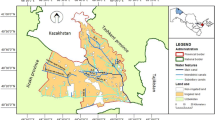Abstract
This paper reports on how prior information was used as a source of data for sampling schemes as well as a foundation for further salinity studies at different scales. The results at each of the scale levels are useful to the degree of sampling intensity at which the information was obtained. While the regional study revealed the salinity pattern is closely associated with climatic trend, the pattern of salinity at the county scale is less well-defined. The salinity information at the field scale revealed high saline areas coinciding with an abandoned creek channel. The salinisation process at this scale is probably due to deposition of soluble salts that have been flushed from the upper reaches of an abandoned creek. There is preponderance of saline subsoil layers in and around Mungindi which needs further investigation. Visualisation of information transfer through the scale continuum, as demonstrated by this study, is presented and discussed.
Similar content being viewed by others
References
Bouma J (1996) Role of quantitative approaches in soil science when interacting with stakeholders. Proc Aust NZ Nat Soil Conf, July 1996, Vol 1 Plenary Papers p67–72.
Bregt AK (1992) Processing of Soil Survey data. Doctoral Thesis. Wageningen Agricultural University, Wageningen, the Netherlands, pp41–53.
Campbell A and Siepen G (1994) Landcare. Communities Shaping the Land and the Future. Allen & Unwin Pty Ltd, St Leonards, Australia.
Hoosbeek MR and Bryant RB (1992) Towards the quantitative modelling of pedogenesis–a review. Geoderma, 55: 183–210.
Journel AG and Huijbregts ChJ (1978) Mining Geostatistics. Academic Press, London.
Laurie Montgomerie & Pettit Pty Ltd (1983) Macintyre Valley, New South Wales Inland Rivers Flood Plain Management Studies. Water Resource Commission, Sydney, NSW Australia
Matheron G (1971) The Theory of Regionalised Variables and its Applications. Cahiers du Centre de Morphologie Mathematique de Fountainbleau no 5.
McGarry D, Ward WT and McBratney AB (1989) Soil Studies in the Lower Namoi Valley–Methods and Data Set. CSIRO, Australia Division of Soils.
Odeh IOA, McBratney AB and Chittleborough DJ (1994) Spatial prediction of soil properties from landform attributes derived from a digital elevation model. Geoderma 63: 197– 214.
Triantafilis J (1996) Quantitative Assessment of Soil Salinity in the Lower Namoi Valley. Doctoral Thesis, Faculty of Agriculture, University of Sydney. 323pp.
Triantafilis J and McBratney AB (1993) Application of Continuous Methods of Soil Classification and Land Suitability Assessment in the Lower Namoi Valley. CSIRO Div. Soils Divisional Report No. 122. Canberra Australia.
van der Lelij A (1983) Use of Electromagnetic Induction Instrument (Type EM38) for Mapping of Soil Salinity. Internal Report Branch, Water Resources Commission, NSW, Australia.
Webster R and Oliver MA (1990) Statistical Methods in Soil and Land Resource Survey. Oxford Univ. Press, Oxford
Voltz M and Webster R (1990) A comparison of kriging, cubic splines and classification for predicting soil properties from sample information. J Soil Sci 41: 473–490.
Author information
Authors and Affiliations
Rights and permissions
About this article
Cite this article
Odeh, I., Todd, A., Triantafilis, J. et al. Status and trends of soil salinity at different scales: the case for the irrigated cotton growing region of eastern Australia. Nutrient Cycling in Agroecosystems 50, 99–107 (1998). https://doi.org/10.1023/A:1009763522702
Issue Date:
DOI: https://doi.org/10.1023/A:1009763522702



